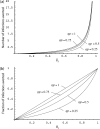When is quarantine a useful control strategy for emerging infectious diseases?
- PMID: 16421244
- PMCID: PMC7109638
- DOI: 10.1093/aje/kwj056
When is quarantine a useful control strategy for emerging infectious diseases?
Abstract
The isolation and treatment of symptomatic individuals, coupled with the quarantining of individuals that have a high risk of having been infected, constitute two commonly used epidemic control measures. Although isolation is probably always a desirable public health measure, quarantine is more controversial. Mass quarantine can inflict significant social, psychological, and economic costs without resulting in the detection of many infected individuals. The authors use probabilistic models to determine the conditions under which quarantine is expected to be useful. Results demonstrate that the number of infections averted (per initially infected individual) through the use of quarantine is expected to be very low provided that isolation is effective, but it increases abruptly and at an accelerating rate as the effectiveness of isolation diminishes. When isolation is ineffective, the use of quarantine will be most beneficial when there is significant asymptomatic transmission and if the asymptomatic period is neither very long nor very short.
Figures




